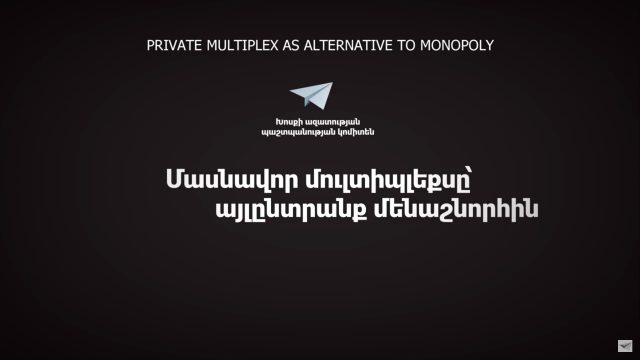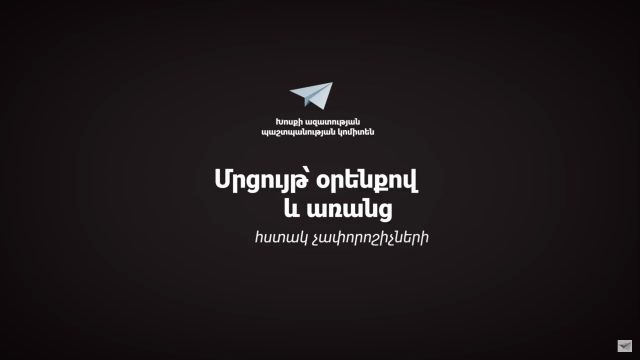The transition from the analogue to digital broadcasting in Armenia generated new problems: 10 television companies were excluded from the process. 34 existing television companies found themselves in a single broadcasting network – the public multiplex, whereas no private multiplexes were created.
“If there is only one public network with no private multiplexes, then it means this is the only option and it contradicts the very idea of a social package. As a result, the overground broadcasting becomes a privilege rather than a right”, Boris Navasardyan, President of Yerevan Press Club opines.
The transition from the analogue to digital broadcasting is an international process and implies creating private networks in addition to the public one, which is important in terms of stimulating competition and upgrading the relations in the sector.
Karine Haroutyunyan, Executive Director of GALA TV believes that any government may at any time decide not to include any of the television companies in the public multiplex, “while a private multiplex, especially its small localised version would give freedom to any television company. Normally, the number of broadcasters increases as a result of digitalisation while they decided to cut their number in Armenia. This is nonsense”.
By granting a broadcasting licence to one television company only from each marz the State excluded more than a dozen broadcasters from the process. Those in charge of the sector allowed them continuing analogue broadcasting by making amendment to the RA Law on Television and Radio in order for avoiding the labelling of what had happened as a political decision, however the future of these television companies is quite unclear. According to Boris Navasardyan, President of YPC, when you do not have an idea what future awaits you, you cannot make development plans to understand how in the final analysis the demand will be formed.
Karine Haroutyunyan, Executive Director of “GALA” TV: “We lost one-third of our viewers. Our technical staff visited people’s homes, set up devices, did some things so they could watch GALA”.
Khachik Danielyan, the founder of the television company ALT in Armavir expresses his concern: “Our licences were extended for an indefinite period prior to the emergence of a private multiplex. However, the conditions put forward to us were such that no private multiplex would created. I even proposed to permit us to create a private multiplex by ourselves. They did not agree. The matter could have been resolved by very small investments and transitional provisions in the law. Let them be honest and openly state that they decided to close us down, that by keeping us they just cheat the Europeans.’
One digital television company – GEGHAMA – exists as a result of a merger of three television companies from Sevan, Martuni and Gavar in Gegharkounik marz. Souren Barseghyan, the director of the company belives that this could serve as a good example to the rest. However, Samvel Haroutyunyan, the founder of the MIG television company in Vanadzor believes that this is not possible in Lori: “Let them allow me to work with my television tower, with my building and build my multiplex on my tower. Let the law introduce no limitations on this”.
For comparison it should be noted that no marz television company was excluded from the digitalisation process in the neighboring Georgia. Private multiplexes were created along with the public one and there was competition.
Natia Kuprashvili, Executive Director of the Journalism Resource Center in Georgia who played an important role in the digitalisation of broadcasting in her country, describes Georgian experience: “Creating opportunities for television companies is a state obligation and broadcasters must not suffer losses as a result of reform. This is the most important thing. If we are speaking about informational security, it is necessary to have several multiplexes because in case of one multiplex something may happen to it whereas if there are several, they act as a safeguard to one another. Our experience demonstrates that having diversified infrastructures is very important”.
Thus, there is one public and three private multiplexes in Georgia that ensure national coverage and 20 marz multiplexes, each of which have 1-2 broadcasters and whose owners are the marz broadcasters. Moreover, the state gave these multiplexes to marz companies and also reimbursed them the money that they had paid for digitalisation. Natia Kuprashvili stresses that there are also free places in the public multiplex ensuring public broadcasting. However, they cannot be sold as long as the private ones have free places. This is the requirement of the law. This means that the priority is given to the private one. In Armenia, on the other hand, there is no alternative to the public digital network and it is not known yet when the private will enter the market.
Nune Sargsyan, Executive Director of the Media Initiatives Center presents an alternative approach: “We propose that the public multiplex is busy with public commissions only and broadcasts the social package only. This would create a more favourable situation for the existence of private multiplexes. Therefore, we would have quite a large group of television companies, which would create a demand for private multiplexes”.
After the legislative amendments in 2015 3 tenders for licensing a private multipex were annulled due to absence of applicants. What are the obstacles to the emergence of private multiplexes? The first obstacle is the law itself.
“The law foresaw such conditions that would not allow any private investor to enter the market”, Tigran Hakobyan, Chairman of the Television and Radio Commission.
Gagik Aloyan, Executive Director of Armenian Television and Radio Network CJSC believes that it is important that the law foresees the idea of a private multiplex. Sadly, the process is complicated: “This is a matter for the legislator: it should be neither too simple nor too complicated. In other words, a golden medium must be found. Prominent companies must be involved to deal with this”.
According to the current law, the private multiplex must encompass the whole of the territory of Armenia must be owned in its entirety (no leasing is possible) and the state fee must be 100 mln AMD.
Three media organisations – The Committee to Protect Freedom of Speech, the Media Initiatives Center and Yerevan Press Club – are currently in the process of drafting a new Law on Television and Radio, which proposes the following solution to the issue: first, the multiplex can cover one or more communities, one or more marzes, as well as the whole territory of the state. Apart from this, it is not necessary for the whole network to belong to one owner. Leasing of some infrastructures is also possible. It also foresees dramatic reduction of the state fee.
Thus, the state structures and large businesses will not have a monopoly, which is allowed by the current law. Instead, wide opportunities will be foreseen also for small and medium enterprises. The main goal would be to liberate the relations in the sector and to stimulate competition.
HASMIK BUDAGHYAN
CPFE expert

























































